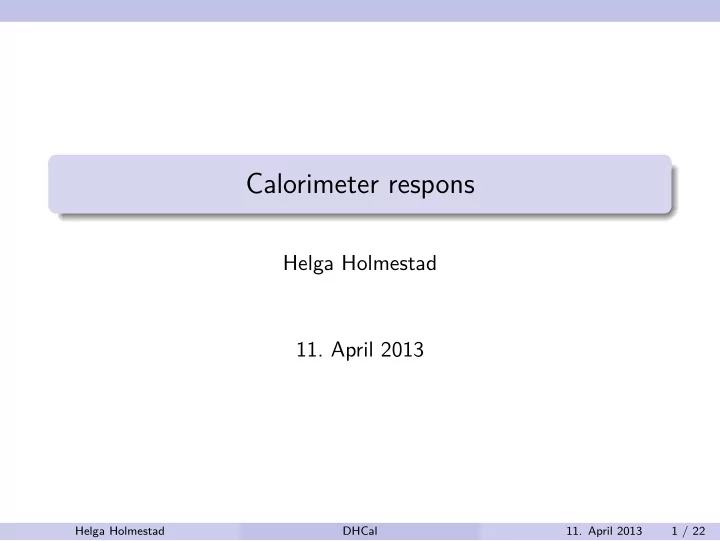

Calorimeter respons Helga Holmestad 11. April 2013 Helga Holmestad DHCal 11. April 2013 1 / 22
Particle selection • Distinguish between muons/electrons/pions • How: • Cherenkov counters (electrons) • Density (Number of hits/ Active Layers) • Total RMS/Active Layers • Make histogram of these variables. Then two clearly separable regions should be seen. These plots decide where to put the cuts. Helga Holmestad DHCal 11. April 2013 2 / 22
7 GeV beam 270 GeV beam density density density density density density Entries 165526 Entries 30099 Mean 3.474 Mean 31.93 RMS 1.754 4000 RMS 20.73 20000 18000 3500 16000 3000 14000 2500 12000 10000 2000 8000 1500 6000 1000 4000 500 2000 0 0 0 2 4 6 8 10 12 0 10 20 30 40 50 60 70 80 90 TotalNumberOfHits/activeLayers TotalNumberOfHits/activeLayers TotalRMS/ActiveLayers TotalRMS/ActiveLayers TotalRMS/ActiveLayers TotalRMS/ActiveLayers TotalRMS/ActiveLayers TotalRMS/ActiveLayers Entries 165526 Entries 30099 Mean 11.97 Mean 44.34 9000 RMS 10.32 RMS 26.57 800 8000 700 7000 600 6000 500 5000 400 4000 300 3000 200 2000 100 1000 0 0 0 10 20 30 40 50 60 70 0 10 20 30 40 50 60 70 80 90 TotalRMS/activeLayers TotalRMS/activeLayers Helga Holmestad DHCal 11. April 2013 3 / 22
The cuts • The cuts used are showed in the table below. • Because the tailcatcher hits are not used I tried to take away events which could leak energy. (Only done for runs with higher energy than 50 GeV). • This was done by excluding the events which had less than 25 hits in the 10 first layers, this should exclude the events with late shower start. Energy density cut centerRMS cut 7 GeV 2 1.8 10 GeV 2 1.8 50 GeV 3 3 270 GeV 12 23 300 GeV 15 25 Helga Holmestad DHCal 11. April 2013 4 / 22
Fitting a Gaussian • The number of hits from the pion events is assumed to be Gaussian distributed, when no saturation occurs. • I have fitted a Gaussian function in the interval ± RMS from the arithmetic mean. • This is done to be independent of outliers • Outliers whit large energy looks like box events not found by the Box Event finder. • Outliers with low energy? 7 GeV 270 GeV Hit distribution Hit distribution Hit distribution Hit distribution Hit distribution Hit distribution Entries 165526 Entries 30099 8000 Mean 67.1 Mean 1162 3500 Before cuts RMS 19.75 Before cuts RMS 762.3 7000 After cuts 3000 After cuts 6000 2500 5000 2000 4000 1500 3000 1000 2000 1000 500 0 0 0 20 40 60 80 100 120 140 160 0 500 1000 1500 2000 2500 3000 Number of hits Number of hits Helga Holmestad DHCal 11. April 2013 5 / 22
• For each energy I take the mean of the fitted Gaussian. • Need to do more... Helga Holmestad DHCal 11. April 2013 6 / 22
A first look at the MC data 10 GeV 50 GeV Hit distribution Hit distribution Hit distribution Hit distribution Hit distribution Hit distribution 350 Entries 9966 Entries 2948 Mean 100.8 Mean 395.5 Before cuts RMS 24.06 Before cuts RMS 89.23 120 300 After cuts After cuts 100 250 80 200 60 150 40 100 20 50 0 0 0 20 40 60 80 100 120 140 160 180 0 100 200 300 400 500 600 700 800 Number of hits Number of hits Energy efficiency muons going trough the cuts 5 GeV 97.81 % 50 GeV 97.76 % 300 GeV 0.275% Helga Holmestad DHCal 11. April 2013 7 / 22
Recommend
More recommend